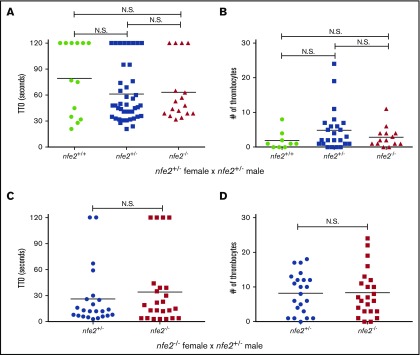Figure 3.
Thrombocyte aggregation is unaffected in nfe2−/−larvae. Offspring from an nfe2+/− incross were collected and tested for the ability to form thrombocyte-rich clots in response to laser-mediated endothelial injury of the dorsal aorta at 6 dpf. (A) No significant difference was found in time to occlusion (TTO) among nfe2+/+, nfe2+/−, or nfe2−/− siblings. (B) The number of fluorescent thrombocytes recruited to the site of injury were counted using fish in the Tg(cd41:egfp) background. There was no significant difference in the total number of thrombocytes between any of the genotypes (wild-type and homozygous, P = .27; wild-type and heterozygous, P = .11; heterozygous and homozygous, P = .39; Mann-Whitney U test). (C-D) Homozygous mutant female fish were bred to heterozygous males to test whether maternal contribution might affect the observed phenotypes. No difference in either TTO (C) or total number of thrombocytes (D) was observed between nfe2−/− and nfe2+/− siblings from this cross. Horizontal bars indicate the median TTO and number of thrombocytes in panels A and C and B and D, respectively.

